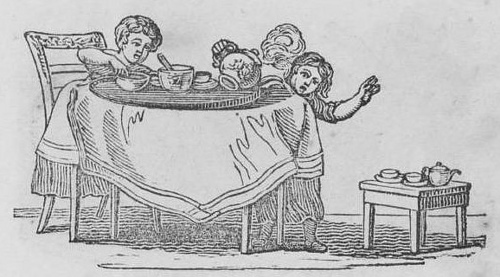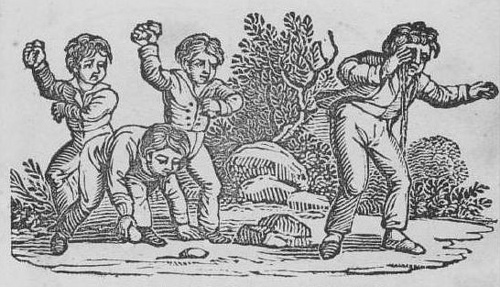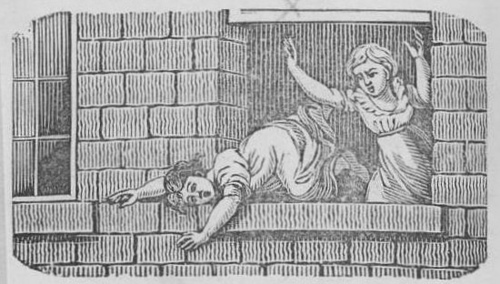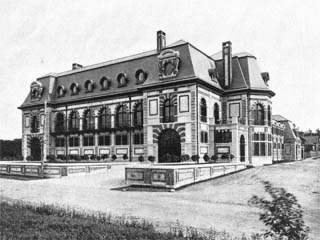decemnovenarianize
v. to act like a person of the 19th century
A Myth Melts
On Nov. 1, 1986, Nancy C. Knight collected two identical snowflakes on a glass plate about 20,000 feet over Wausau, Wis.
“In many years of snow-crystals collection,” she wrote in the Bulletin of the American Meteorological Society, “the author has seen no other example of such crystals, nor are any given in the standard references.”
Safety First
More valuable safety lessons for your children, from The Book of Accidents (1831):

“Little children who can just reach to the top of a table, often endeavor to drink from the spout of a tea-pot; and in consequence scald their mouths and throats, and die miserable deaths in a few hours.”

“Wicked and malicious boys often throw stones, by which they not only hurt and maim one another, but often knock out an eye and are disfigured for life.”

“Hundreds of children are killed every year by leaning out of windows. … In another moment [this little girl] may be dashed upon the rocky pavement below, to be picked up by her parents a mangled corpse.”
Bonus parable: “The writer knows of a little boy who was very fond of being in the kitchen, that he might see how Johnny-cakes and pies, and all such things were made, and from his talkativeness occasioned considerable trouble. In the absence of the cook for a short time, what should he do but go and sit himself down into a kettle of boiling hot water! His screams soon brought his mother, and with difficulty his life was saved.”
A Rude Awakening
On the 3rd of this month, Nicephorus Glycas, the Greek-Orthodox Metropolitan of Lesbos, an old man in his eightieth year, after several days of confinement to his bed, was reported by the physician to be dead. The supposed dead bishop, in accordance with the rules of the Orthodox Church, was immediately clothed in his episcopal vestments, and placed upon the Metropolitan’s throne in the great church of Methymni, where the body was exposed to the devout faithful during the day, and watched by relays of priests day and night. … On the second night of ‘the exposition of the corpse,’ the Metropolitan suddenly started up from his seat and stared round him with amazement and horror at all the panoply of death amidst which he had been seated. The priests were not less horrified when the ‘dead’ bishop demanded what they were doing with him. The old man had simply fallen into a death-like lethargy, which the incompetent doctors had hastily concluded to be death.
— London Echo, March 3, 1896, quoted in William Tebb, et al., Premature Burial and How It May Be Prevented, 1905
The Doctrinal Paradox
You’re overseeing a murder trial. The defendant will be hanged if his crime is judged to be both willful and premeditated. You poll the jurors:

A majority think it was willful, and a majority think it was premeditated, so you order the death penalty. As he’s dragged off to the gallows, the defendant screams that this is unfair and swears that his ghost will return for revenge.
You think nothing more of this until the evening, when a strange thought occurs to you. If you’d simply asked the jurors, “Should this man receive the death penalty?”, most would have voted no — only one of the three jurors believed that the crime was both willful and premeditated. Was your own reasoning unsound?
And who’s that behind you — ?
Vide Infra
Edward Edwin Foot was a poet with the mind of an attorney — in his 1865 elegy for Henry Temple, a single verse contains three footnotes:
Altho’ we* mourn for one now gone,
And he — that grey-hair’d Palmerston,†
We will give God the praise,–
For he, beyond the age of man,‡
Eleven years had over-ran
Within two equal days.
*The nation.
†The Right Honourable Henry John Temple, Viscount Palmerston, K.G., G.C.H., &c. (the then Premier of the British Government), died at “Brockett Hall,” Herts, at a quarter to eleven o’clock in the forenoon of Wednesday, 18th October, 1865, aged eighty-one years (all but two days, having been born on the 20th October 1784). The above lines were written on the occasion of his death.
‡Scriptural limitation.
Unquote
“Many might go to heaven with half the labor they go to hell.” — Ben Jonson
The Rich Are Different

Oliver Belmont loved horses so much that he shared his house with them. When planning his summer mansion in Newport, R.I., in 1891, the American socialite insisted that the first floor be devoted to stables, paneled in teak and heated with steam, with quarters for eight grooms. The family lived on the second floor.
That’s not all. Reportedly Belmont’s horses had morning clothes, afternoon clothes, and evening clothes; slept in white linen sheets; and had harness hooks made of sterling silver. Belmont couldn’t bear to part with two of his favorites even at their death, so he had them stuffed and mounted in a drawing room.
“It’s your client’s money you’re spending,” wrote architect Richard Morris Hunt. “If they want you to build a house upside down standing on its chimney, it’s up to you to do it, and still get the best possible results.”
Math Notes
2502 = 2 + 502
Oh, Never Mind
Zhuangzi and Huizi were strolling along the dam of the Hao Waterfall when Zhuangzi said, ‘See how the minnows come out and dart around where they please! That’s what fish really enjoy!’
Huizi said, ‘You’re not a fish — how do you know what fish enjoy?’
Zhuangzi said, ‘You’re not I, so how do you know I don’t know what fish enjoy?’
Huizi said, ‘I’m not you, so I certainly don’t know what you know. On the other hand, you’re certainly not a fish — so that still proves you don’t know what fish enjoy!’
Zhuangzi said, ‘Let’s go back to your original question, please. You asked me how I know what fish enjoy — so you already knew I knew it when you asked the question. I know it by standing here beside the Hao.’
— Zhuangzi, China, fourth century B.C.
